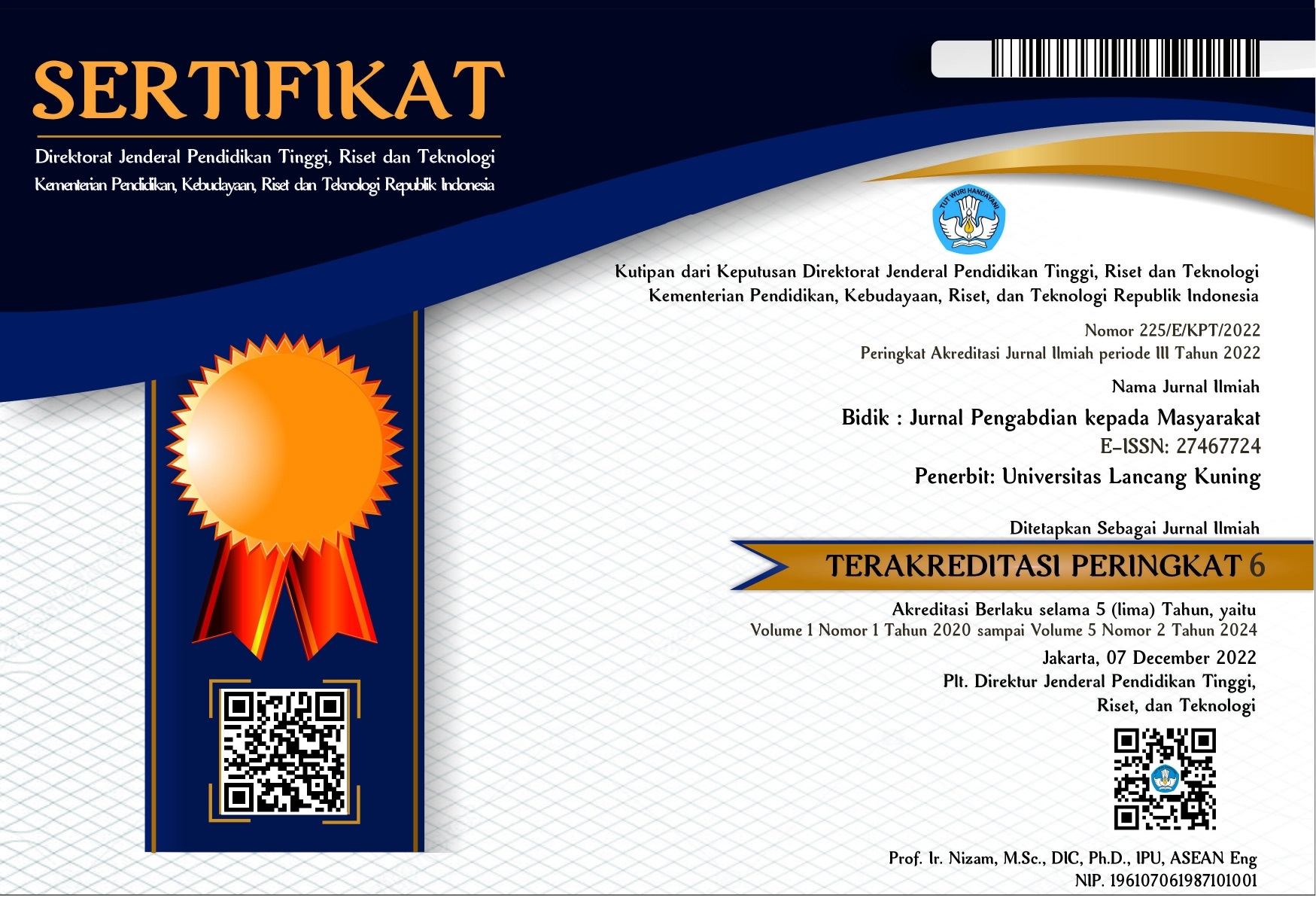Peningkatan Kemampuan Menjadi Mc Pada Acara Resepsi Pernikahan Melayu Riau Pada Siswa SMA Negeri 7 Kecamatan Senapelan Kota Pekanbaru
Abstract
The Master of Ceremony (MC) is a professional event host responsible for guiding and entertaining various events. The MC plays a crucial role in ensuring that events, ranging from formal activities to weddings, run smoothly according to the predetermined schedule provided by event organizers and protocol officers. In addition to this, the MC is tasked with thoroughly understanding the event, as directed by the event organizer. This community service program is organized for the students of SMA Negeri 7 in Senapelan District. Recognizing the significance of fostering and developing Malay culture and the Malay (BMR) region, the Riau Provincial Government has initiated programs in line with the reform era. The primary objective of this program is to enhance the students' abilities to become proficient and professional MCs. The event will focus on interpreting, training, and practicing the art of being an effective MC, particularly for Riau Malay Wedding Receptions.The program aims to contribute to the improvement of MC skills, providing valuable assistance to the students of SMA Negeri 7 in Senapelan District, Pekanbaru. The visiting team from the Faculty of Cultural Studies at Universitas Lancang Kuning is expected to aid the school and its students in understanding Riau Malay culture, with a specific focus on improving MC capabilities for Riau Malay Wedding Receptions. In today's era, those who possess a strong understanding of this field are taking significant strides, and the demand for professionals in this domain is on the rise.
Downloads
References
Budiawan, A. (2021). Tinjauan al Urf dalam Prosesi Perkawinan Adat Melayu Riau. Jurnal An-Nahl, 8(2), 115–125. https://doi.org/10.54576/annahl.v8i2.39
Ediruslan, P. A. (2000). Senarai Upacara Adat Perkawinan Melayu Riau. Pemerintah Propinsi Riau dan Dewan Kesenian Riau.
Fatimah, R. P. S. N., Murtadho, F., & Zuriyati. (2022). Fungsi Pantun Adat Perkawinan Melayu Riau (Pantun Function as Malay Marriage Tradition of Riau). Indonesian Language Education and Literature, 7(2).
FKIP UM Surabaya. (2023, July 16). Mengapa Menjadi MC Yang Baik Itu Penting? Begini menurut Pheni Cahya Kartika Dosen PBSI UM Surabaya. UM Surabaya. https://fkip.um-surabaya.ac.id/homepage/news_article?slug=mengapa-menjadi-mc-yang-baik-itu-penting-begini-menurut-pheni-cahya-kartika-dosen-pbsi-um-surabaya-1#:~:text=Menjadi%20MC%20yang%20baik%20sangat%20penting%20karena%20MC,gaya%20bicaranya%20yang%20jelas%2C%20lugas%2C%20dan%20mudah%20dipahami.
Hamidin, A. S. (2020). Belajar Pidato & MC: Panduan Mudah & Cepat Memukau Audience dengan Percaya Diri. Anak Hebat Indonesia.
Jamil, Nizami. H. O. K., Zaidi, H., Nasir, Aziz, M., Rahimah, Mahdar, S. W., & Zulkifli. (2005). Pakaian Tradisional Melayu Riau. LPNU Press bekerjasama dengan Lembaga Adat Melayu Riau.
Saiful Arif. (2019). Penggunaan Metode Ceramah Variasi Yang Disertai Kemampuan Orientasi Terhadap Peningkatan Kualitas Pembelajaran Ekonomi Siswa Kelas X - 8 SMAN 1 Paciran Lamongan. Jurnal Pendidikan Islam, 5(2), 193–200. https://doi.org/10.37286/ojs.v5i2.55
Wirabumi, R. (2020). Metode Pembelajaran Ceramah. Annual Conference on Islamic Education and Thought , 1(1), 105–113.
Zaduqisti, E. (2010). Problem-Based Learning (Konsep Ideal Model Pembelajaran Untuk Peningkatan Prestasi Belajar Dan Motivasi Berprestasi. Forum Tarbiyah, 8(2).
Bidik: Jurnal Pengabdian kepada Masyarakat memegang hak cipta artikel yang diterbitkan di bawah ketentuan Creative Commons Attribution-ShareAlike 4.0. International License. Siapa pun dapat menyalin, mengubah, atau mendistribusikan ulang artikel untuk tujuan apa pun yang sah dan bertanggung jawab di media apa pun, dengan catatan memberikan kredit yang sesuai kepada penulis asli dan Jurnal Bidik, menautkan ke lisensi, menunjukkan jika ada perubahan, dan mendistribusikan ulang karya turunan apa pun di bawah lisensi yang sama.
Setelah artikel dinyatakan diterima dan dipublikasikan di situs web ini, ini berarti penulis sepenuhnya setuju untuk menyerahkan hak cipta kepada Bidik: Jurnal Pengabdian kepada Masyarakat.








